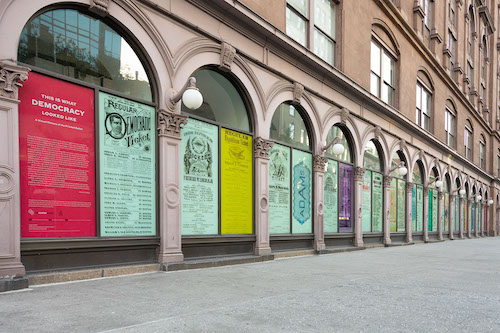This is What Democracy Looked Like
Mon, Oct 19, 2020 12pm - Sat, Nov 7, 2020 12pm

Sample historical ballots, including South Division ballot for Democratic presidential electors (1864), Regular Republican Ticket, MA (1878), Independent Greenback Ticket, MA (1878), and Independent Taxpayers Union Ticket, CA (1871).
“This is What Democracy Looked Like: A Visual History of the Printed Ballot,” a new exhibition in the colonnade windows of the Foundation Building, showcases historical election ballots, or what some have called “fugitive ephemera.” (Printed ballots in the United States are legally required to be destroyed so surviving pieces are rare—and perhaps prohibited.) The exhibition highlights how the visual history of the printed ballot illuminates the noble, but often flawed process at the heart of US democracy. Presented by Cooper’s Herb Lubalin Study Center of Design and Typography, “This is What Democracy Looked Like” features print reproductions of 26 individual ballots from the nineteenth century, culled from curator Alicia Cheng’s recent book of the same name.
Can't visit the Foundation Building? See the full exhibition online.

The 26 historical ballots on view offer insight into a pivotal time in American history, tracing the explosive growth of an evolving electorate as well as a legacy of electoral fraud and disenfranchisement. Before the 20th century there was no federal oversight for the election ballot. In fact, the parties paid to produce, print, and distribute their own ballots. It was a time of extreme partisanship that demanded adherence to a single party since voters were required to vote the full ticket, so ballots were designed to be eye-catching propaganda. Parties used colored inks, paper stock or illustrations (in some cases blatantly racist and xenophobic slogans) explicitly so party members could easily track which votes were cast, evidence of early methods of voter suppression and intimidation. By the early 20th century, a federally regulated ballot was introduced, leading to a design more familiar to us today. This new format is obviously fraught with problems that continue now, such confusion of what to mark or where to mark (think of this century’s infamous “hanging chad”).
Register for the panel in conjunction with the exhibition featuring Samantha Bee, Zephyr Teachout, Victoria Bassetti, and curator Alicia Cheng.
Located at 7 East 7th Street, between Third and Fourth Avenues




